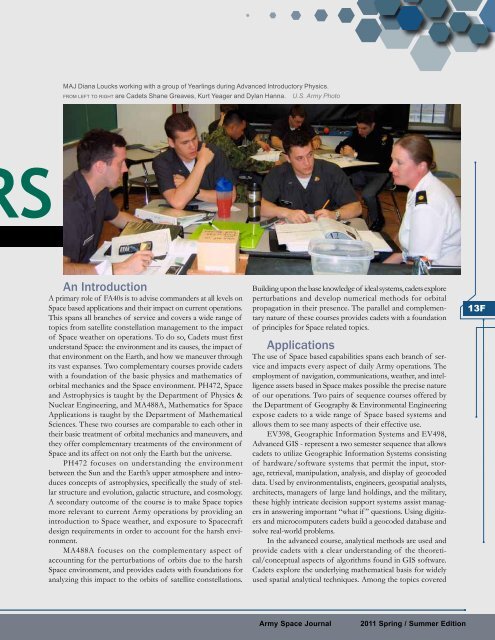Spring 2011 - Space and Missile Defense Command - U.S. Army
Spring 2011 - Space and Missile Defense Command - U.S. Army
Spring 2011 - Space and Missile Defense Command - U.S. Army
Create successful ePaper yourself
Turn your PDF publications into a flip-book with our unique Google optimized e-Paper software.
MAJ Diana Loucks working with a group of Yearlings during Advanced Introductory Physics.<br />
from left to right are Cadets Shane Greaves, Kurt Yeager <strong>and</strong> Dylan Hanna. U.S. <strong>Army</strong> Photo<br />
s<br />
An Introduction<br />
A primary role of FA40s is to advise comm<strong>and</strong>ers at all levels on<br />
<strong>Space</strong> based applications <strong>and</strong> their impact on current operations.<br />
This spans all branches of service <strong>and</strong> covers a wide range of<br />
topics from satellite constellation management to the impact<br />
of <strong>Space</strong> weather on operations. To do so, Cadets must first<br />
underst<strong>and</strong> <strong>Space</strong>: the environment <strong>and</strong> its causes, the impact of<br />
that environment on the Earth, <strong>and</strong> how we maneuver through<br />
its vast expanses. Two complementary courses provide cadets<br />
with a foundation of the basic physics <strong>and</strong> mathematics of<br />
orbital mechanics <strong>and</strong> the <strong>Space</strong> environment. PH472, <strong>Space</strong><br />
<strong>and</strong> Astrophysics is taught by the Department of Physics &<br />
Nuclear Engineering, <strong>and</strong> MA488A, Mathematics for <strong>Space</strong><br />
Applications is taught by the Department of Mathematical<br />
Sciences. These two courses are comparable to each other in<br />
their basic treatment of orbital mechanics <strong>and</strong> maneuvers, <strong>and</strong><br />
they offer complementary treatments of the environment of<br />
<strong>Space</strong> <strong>and</strong> its affect on not only the Earth but the universe.<br />
PH472 focuses on underst<strong>and</strong>ing the environment<br />
between the Sun <strong>and</strong> the Earth’s upper atmosphere <strong>and</strong> introduces<br />
concepts of astrophysics, specifically the study of stellar<br />
structure <strong>and</strong> evolution, galactic structure, <strong>and</strong> cosmology.<br />
A secondary outcome of the course is to make <strong>Space</strong> topics<br />
more relevant to current <strong>Army</strong> operations by providing an<br />
introduction to <strong>Space</strong> weather, <strong>and</strong> exposure to <strong>Space</strong>craft<br />
design requirements in order to account for the harsh environment.<br />
MA488A focuses on the complementary aspect of<br />
accounting for the perturbations of orbits due to the harsh<br />
<strong>Space</strong> environment, <strong>and</strong> provides cadets with foundations for<br />
analyzing this impact to the orbits of satellite constellations.<br />
Building upon the base knowledge of ideal systems, cadets explore<br />
perturbations <strong>and</strong> develop numerical methods for orbital<br />
propagation in their presence. The parallel <strong>and</strong> complementary<br />
nature of these courses provides cadets with a foundation<br />
of principles for <strong>Space</strong> related topics.<br />
Applications<br />
The use of <strong>Space</strong> based capabilities spans each branch of service<br />
<strong>and</strong> impacts every aspect of daily <strong>Army</strong> operations. The<br />
employment of navigation, communications, weather, <strong>and</strong> intelligence<br />
assets based in <strong>Space</strong> makes possible the precise nature<br />
of our operations. Two pairs of sequence courses offered by<br />
the Department of Geography & Environmental Engineering<br />
expose cadets to a wide range of <strong>Space</strong> based systems <strong>and</strong><br />
allows them to see many aspects of their effective use.<br />
EV398, Geographic Information Systems <strong>and</strong> EV498,<br />
Advanced GIS - represent a two semester sequence that allows<br />
cadets to utilize Geographic Information Systems consisting<br />
of hardware/software systems that permit the input, storage,<br />
retrieval, manipulation, analysis, <strong>and</strong> display of geocoded<br />
data. Used by environmentalists, engineers, geospatial analysts,<br />
architects, managers of large l<strong>and</strong> holdings, <strong>and</strong> the military,<br />
these highly intricate decision support systems assist managers<br />
in answering important “what if ” questions. Using digitizers<br />
<strong>and</strong> microcomputers cadets build a geocoded database <strong>and</strong><br />
solve real-world problems.<br />
In the advanced course, analytical methods are used <strong>and</strong><br />
provide cadets with a clear underst<strong>and</strong>ing of the theoretical/conceptual<br />
aspects of algorithms found in GIS software.<br />
Cadets explore the underlying mathematical basis for widely<br />
used spatial analytical techniques. Among the topics covered<br />
13F<br />
<strong>Army</strong> <strong>Space</strong> Journal<br />
<strong>2011</strong> <strong>Spring</strong> / Summer Edition
















